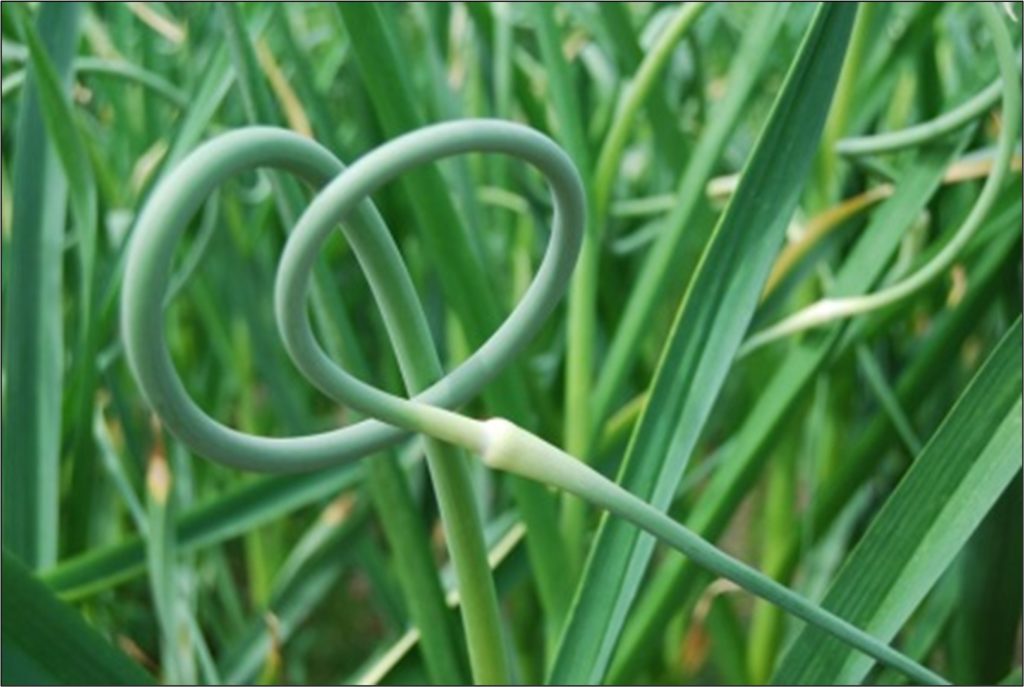
Mary Miller | Gardens on Spring Creek
Garlic, a revered staple in kitchens around the world, is documented to have been cultivated for 5,000 years and is among the oldest known cultivated crops. Today wild garlic grows only in Central Asia; historically it grew in many additional regions. Globally there are 2.5 million acres cultivated with a yield of 10 million metric tons! Consider growing garlic in your own garden.
Garlic Types
Hardneck garlics are quite cold-hardy and have an array of flavor profiles. These varieties will form flower stalks called “scapes” that should be cut back one to two inches above the top leaf after they begin to curl. Scapes are a delicious way to add mild garlic flavor to a variety of dishes. The cloves of hardneck garlic are typically large, uniform, and easy to peel.
Softneck varieties are what is typically found in grocery stores and are mild, with smaller cloves. Softneck garlic rarely produces scapes and the stalks may be easily braided for decorative purposes.
Preparation
Garlic is planted in the autumn for harvest the following summer. What is called “seed garlic” is graded premium garlic offered as large bulbs capable of producing large heads. Seed garlic may be found in most local nurseries in the fall, from mail-order seed companies or local farmers.
Garlic grows best in well-drained and loose soil and is a heavy feeder of nitrogen. Prepare your bed by tilling in compost, leaves, or other well-aged organic matter. The lighter the soil, the larger your garlic will grow.
Planting
Garlic is best planted in October. Separate the garlic cloves, no need to peel them. Plant the cloves with the pointy side up, four to six inches apart, and cover with two to four inches of loose soil. Mulch the garlic after planting with several inches of weed-free straw or dry leaves. Water the garlic thoroughly at the time of planting. Secure the mulch from blowing away with bird netting or floating row cover. Secure the covering with landscape pins or stones laid along the edges. One pound of seed garlic bulbs plants approximately a 25-foot row with four-inch spacing between plants. The optimum yield is 10 pounds for each pound planted.

Growing
Remove the covering and leave the mulch in spring to help suppress weeds and retain moisture. It is important to keep the garlic well-watered, requiring approximately one inch of water per week during the growing season.
Harvest and Storage
Garlic is best harvested when the lower four to five leaves have yellowed, usually in July. Taper the watering for two weeks prior to harvest. Carefully dig the garlic and avoid pulling on the stalk as it may separate from the bulb. Gently remove excess soil, and do not wash the bulbs. Promptly bundle and hang the plants or spread them on a screen or rack in a shady place with good air circulation to further dry, a process called curing. After two to four weeks, or once the garlic is thoroughly dried, trim the roots and cut back the stalks to about one and a half inches above the bulb.
Garlic can be stored in a mesh bag in a cool, dry area. The optimum storage temperature is 50 – 60 degrees Fahrenheit. Save the largest bulbs for replanting in the autumn!
Support Northern Colorado Journalism
Show your support for North Forty News by helping us produce more content. It's a kind and simple gesture that will help us continue to bring more content to you.
BONUS - Donors get a link in their receipt to sign up for our once-per-week instant text messaging alert. Get your e-copy of North Forty News the moment it is released!
Click to Donate

